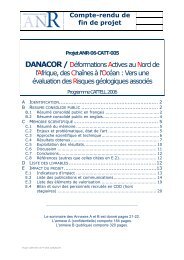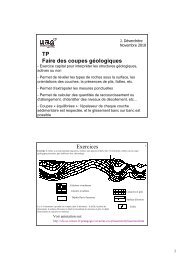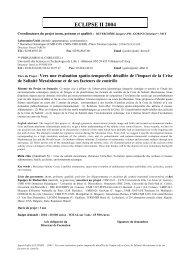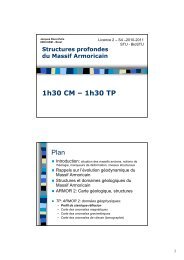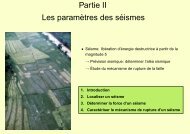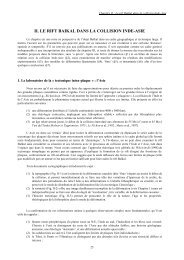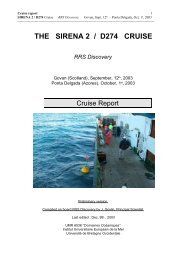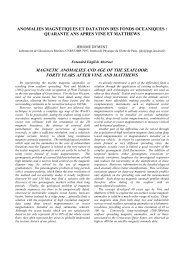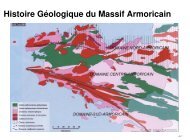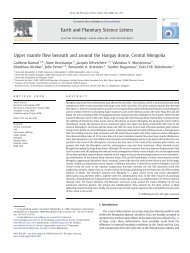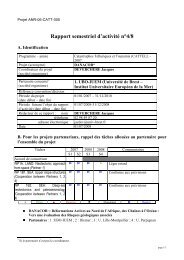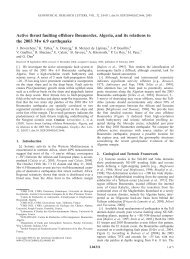The Khayr al Din bank - liste des personnes ayant une page web
The Khayr al Din bank - liste des personnes ayant une page web
The Khayr al Din bank - liste des personnes ayant une page web
- No tags were found...
You also want an ePaper? Increase the reach of your titles
YUMPU automatically turns print PDFs into web optimized ePapers that Google loves.
Tectonophysics 475 (2009) 98–116Contents lists available at ScienceDirectTectonophysicsjourn<strong>al</strong> home<strong>page</strong>: www.elsevier.com/locate/tectoPlio-Quaternary reactivation of the Neogene margin off NW Algiers, Algeria: <strong>The</strong><strong>Khayr</strong> <strong>al</strong> <strong>Din</strong> <strong>bank</strong>Abdelkarim Yelles a , Anne Domzig b,c,1 , Jacques Déverchère b,c, ⁎, Rabah Bracène d ,Bernard Mercier de Lépinay e , Pierre Strzerzynski b,c , Guillaume Bertrand f , Azzedine Boudiaf a ,Thierry Winter f , Abdelaziz Kherroubi a , Pasc<strong>al</strong> Le Roy b,c , Hamou Djellit aa Centre de Recherche en Astronomie, Astrophysique et Géophysique (C.R.A.A.G.), BP 63, Bouzareah, Algiers, Algeriab Université Européenne de Bretagne, Francec Université de Brest; CNRS, UMR 6538 Domaines Océaniques; Institut Universitaire Européen de la Mer, Place Copernic, 29280 Plouzané, Franced Sonatrach Exploration, avenue du 1er Novembre, Boumerdès, Algeriae Géosciences Azur, CNRS-UMR 6526, 250 rue Albert Einstein, bât. 4, 06560 V<strong>al</strong>bonne, Francef BRGM, 3 avenue Claude Guillemin, BP 36009, 45060 Orléans Cedex 2, FrancearticleinfoabstractArticle history:Received 16 April 2008Received in revised form 17 October 2008Accepted 25 November 2008Available online 6 December 2008Keywords:Algerian marginContraction<strong>al</strong> reactivationActive fault-related foldsSeismic hazardSeismic reflectionAfrica-Eurasia convergenceTiltingOcean-continent transition<strong>The</strong> Algiers region, northern Algeria, is known to be seismic<strong>al</strong>ly active, with recurrent large (MN6)earthquakes. Because of the lack of high-resolution bathymetry, the offshore structures remained for a longtime poorly known. Thanks to a new marine data base (MARADJA 2003 cruise), the offshore part of themargin is accurately mapped, and new active and recent structures are <strong>des</strong>cribed. West of the bay of Algiers,the margin enlarges, forming the <strong>Khayr</strong> <strong>al</strong> <strong>Din</strong> <strong>bank</strong>, interpreted as a tilted block of the passive margin bornduring the opening of the Algero-Provenç<strong>al</strong> basin. At the slope break, a 80 km-long fault-tip Quaternary fold,namely the <strong>Khayr</strong> <strong>al</strong> <strong>Din</strong> fault, extends at the foot of the margin off NW Algiers and represents the largestactive structure of the coast<strong>al</strong> area, together with the Sahel anticline. We <strong>al</strong>so map for the first time a set ofoverlapping, en echelon active folds in the upper part of the <strong>Khayr</strong> <strong>al</strong> <strong>Din</strong> <strong>bank</strong>, located off previously knownactive structures on land. Most of these faults represent actu<strong>al</strong>ly a threat for the Algiers region in terms ofseismic hazard but <strong>al</strong>so geologic<strong>al</strong> hazards, such as tsunamis, as most of them depicts significant dimensionsand slip rates. <strong>The</strong> highest long-term horizont<strong>al</strong> shortening rate is found on the <strong>Khayr</strong> <strong>al</strong> <strong>Din</strong> fault and isestimated at 0.5±0.1 mm/yr, with a maxim<strong>al</strong> magnitude of 7.3, which provi<strong>des</strong> one of the highestseismogenic potenti<strong>al</strong> in the region.A new tectonic framework for the Algiers region is proposed, in which the main south-dipping offshorestructure, of opposite vergence relative to most thrusts on land, appears to be nowadays the main drivingfault system, as <strong>al</strong>so found further east in the Boumerdès (M 6.8) 2003 rupture zone. <strong>The</strong> over<strong>al</strong>l apparentpop-up structure of the recent and active faults may result from a progressive migration of the plate limitfrom the Late Miocene, north-dipping suture zone on land, to the Quaternary, south-dipping main <strong>Khayr</strong> <strong>al</strong><strong>Din</strong> fault at sea, suggesting a process of subduction inception.© 2008 Elsevier B.V. All rights reserved.1. Introduction<strong>The</strong> Algiers region (Fig. 1) is located at the boundary between theAfrican continent to the south and the Algero-Provenç<strong>al</strong> basin to thenorth. This basin is thought to have been formed as a back-arc basinbehind the subduction of the Tethyan ocean below the African plate⁎ Corresponding author. Université de Brest; CNRS, UMR 6538 Domaines Océaniques;Institut Universitaire Européen de la Mer, Place Copernic, 29280 Plouzané, France.E-mail address: jacdev@univ-brest.fr (J. Déverchère).1 Now at: Midland V<strong>al</strong>ley Exploration Ltd, 144 West George Street, Glasgow G2 2HG,United Kingdom.during the Miocene (Auzende et <strong>al</strong>.,1973; Réhault et <strong>al</strong>.,1985; Roca et <strong>al</strong>.,2004, and references therein). <strong>The</strong> Intern<strong>al</strong> Zones of the belt driftedsouthward to fin<strong>al</strong>ly collide the African plate ∼18-15 Mys ago (e.g.Alvarez et <strong>al</strong>., 1974; Cohen, 1980; Réhault et <strong>al</strong>., 1984 and referencestherein; Vergés and Sàbat, 1999; Frizon de Lamotte et <strong>al</strong>., 2000; Rocaet <strong>al</strong>., 2004). Since that time, the margin and the whole Alpine belt ofAlgeria have recorded sever<strong>al</strong> stages of shortening, forming the Tell andAtlas folds and thrusts (e.g. Benaou<strong>al</strong>i-Mebarek et <strong>al</strong>., 2006). Nowadays,recent seismicity and neotectonics show that the plate boundaryinvolves most of the Tell- Atlas domain over a broad zone of deformation∼150 km wide (Meghraoui, 1988; Buforn et <strong>al</strong>., 2004; Stich et <strong>al</strong>., 2003),which inclu<strong>des</strong> the deep margin and the Alpine belt. <strong>The</strong> convergencerate between the Eurasian and African continents is presently relatively0040-1951/$ – see front matter © 2008 Elsevier B.V. All rights reserved.doi:10.1016/j.tecto.2008.11.030
A. Yelles et <strong>al</strong>. / Tectonophysics 475 (2009) 98–116Fig. 2. Tectonic framework of the Algiers region (offshore east of Algiers: Déverchère et <strong>al</strong>., 2005), and instrument<strong>al</strong> seismicity (in moment magnitude) (sources: CRAAG cat<strong>al</strong>ogue from year 419 to September 2008, Stich et <strong>al</strong>., 2003, andHarvard CMT cat<strong>al</strong>ogue). BF: Blida fault, ThF: <strong>The</strong>nia fault, MF: Mahelma fault, SA : Sahel anticline, X: Kabylian Intern<strong>al</strong> metamorphic rocks, F: Flyschs, omk: Kabylian Oligo-Miocene, c: Cretaceous, m: Miocene, q: Quaternary, p: Pliocene, v:volcanism. <strong>The</strong> cluster of events located near the shoreline east of ThF corresponds to the westernmost part of aftershocks triggered by the 2003 Mw 6.8 Boumerdès earthquake. Foc<strong>al</strong> mechanisms: 31/10/88: from Harvard-CMT; 10/29/89: fromUSGS; 4/9/96: from IAG; 21/5/03: from Harvard-CMT, relocated by Bounif et <strong>al</strong>. (2004).101
A. Yelles et <strong>al</strong>. / Tectonophysics 475 (2009) 98–116Fig. 4. 3D shaded bathymetric map (25 m resolution DEM) of the <strong>Khayr</strong> <strong>al</strong> <strong>Din</strong> <strong>bank</strong> showing a zoom in the pockmarks field (top inset) and on the lineaments <strong>al</strong>ong the NW-SE slope. In red, the gener<strong>al</strong> tectonic structures as well as thelineaments and sli<strong>des</strong> observed on the <strong>bank</strong>. See location of the block on Fig. 1.103
104 A. Yelles et <strong>al</strong>. / Tectonophysics 475 (2009) 98–116again very narrow, and the transition to the basin is marked by threetopographic breaks striking ∼E-W to ENE-WSW (Fig. 1): a sm<strong>al</strong>l one justa few kilometers from CM (1, Fig.1); a second, steeper one (slopes N 10°),limiting the KADB to the south (2, Fig. 1); and a last one (slopes N 10°),which marks the transition of the KADB to the deep basin (3, Fig. 1).Sever<strong>al</strong> important morphologic<strong>al</strong> features can be distinguished, whichare an<strong>al</strong>ysed below into more details.On land, the topography is dominated by the large Mitidja basin(Fig. 1), striking NE-SW as other Neogene basins of northern Algeria, andby the two intern<strong>al</strong> massifs of Algiers (AM) and Chenoua (CM) whichhave a maximum elevation of approx. 350 m and 850 m respectively. <strong>The</strong>Sahel anticline, the major morphotectonic feature of the area extends<strong>al</strong>ong the coast between AM and CM (Fig.1) and culminates at an <strong>al</strong>titudeof 250 m. It is crosscut by sever<strong>al</strong> transverse structures such as theMahelma fault (MF, Fig. 2)(Boudiaf, 1996).NeartheAM,thedirectionofthe Sahel anticline changes from NE-SW to E-W. A N-S topographicprofile across the Bouzareah massif and Sahel anticline (Fig. 3)evidencestwo topographic sign<strong>al</strong>s of distinct wavelengths: the short wavelengthsouthern topography is the Sahel anticline that grew in response to slip<strong>al</strong>ong the associated Sahel fault; the long wavelength northerntopography is the Bouzareah massif, which uplift maybe reflects slip ona major fault located offshore Algiers, either during the rifting andopening of the Algerian basin or during the later tectonic evolution.4.1. <strong>The</strong> <strong>Khayr</strong> <strong>al</strong> <strong>Din</strong> <strong>bank</strong> (KADB)<strong>The</strong> KADB is a large prominent topographic high, 45 km wide from BouIsmail to the deep basin, overhanging the deep basin of about 1900 m at20 nautic<strong>al</strong> miles from the shoreline (Fig.1). It is about 80 km long in a W-E direction, from the front of the Algiers massif to the north west ofCherchell (west of the Chenoua massif). This <strong>bank</strong> was firstly and briefly<strong>des</strong>cribed by El Robrini (1986) as a recent tilted block of the margin. Itdepicts an over<strong>al</strong>l E-W direction with amajorchangeinaNW-SEdirectionin its eastern tip off Ain Benian (Fig. 1). From East to West, the <strong>bank</strong>changes its morphology - its slope is remarkably smooth, rejuvenated(Fig. 1) -, and gradu<strong>al</strong>ly deepens from a few hundred meters to 2500 mdepth. Around 2.3°E, it is cut by a large canyon, the Chenoua canyon (c.c.,Fig. 1), which extends in the deep basin through a deep-sea fan. Thiscanyon, striking NW-SE, is probably fed by sediments coming from theMazafran river that cuts the Sahel anticline near Zer<strong>al</strong>da, and from theNador river, which reaches the sea near Tipaza city (Fig. 1). In the farwestern end of the KADB, off Gouraya, at 1.9°E (Fig. 1), the <strong>bank</strong> shows achaotic topography with NW-SE trending fractures (“S”, Fig.1) interpretedby Domzig et <strong>al</strong>. (2009) as sli<strong>des</strong> or slumps. West of this area, there are E-W sediment waves that are possibly related to coutourites or turbiditycurrents (Domzig et <strong>al</strong>., in press). In its lower part, the KADB is bordered tothe south-west by a steep slope with triangular chevron-shaped flatsurfaces in the bathymetry (Fig. 1) between canyons, suggesting anapparent norm<strong>al</strong>-fault planes (Domzig et <strong>al</strong>., 2006). Further west (at∼1.8°E, Fig. 1), sever<strong>al</strong> canyons converge at the foot of the slope, at theplace where the <strong>Khayr</strong> <strong>al</strong> <strong>Din</strong> <strong>bank</strong> disappears into the deep basin.4.2. North of the <strong>bank</strong> and deep basinThis northern slope is steep (∼15°) and cut by many gullies (Fig. 4).<strong>The</strong> slope gradient is particularly high compared to other margins notFig. 5. Chirp (high-resolution) seismic lines showing detailed recent sedimentary architecture. (a) Line CL1 in the deep basin, on the eastern flank of the compression<strong>al</strong> ridge; (b) LineCL2 on the shelf (see location on Fig. 1).
A. Yelles et <strong>al</strong>. / Tectonophysics 475 (2009) 98–116Fig. 6. Seismic cross-section (24-channel) MS1 across the <strong>Khayr</strong> <strong>al</strong> <strong>Din</strong> <strong>bank</strong> (see location on Fig. 1) from MARADJA'2003 cruise, including an enlargement (MS1A) on the shelf. Note the presence of a buried fold at the northern end of the linewithin the Plio-Quaternary layers. Vertic<strong>al</strong> exaggeration: 3. Inset : Enlargement with a vertic<strong>al</strong> exaggeration of 6 showing the intern<strong>al</strong> structure of the <strong>Khayr</strong> <strong>al</strong> <strong>Din</strong> <strong>bank</strong> (KADB).105
Fig. 7. Seismic cross-section (24-channel) MS2 across the <strong>Khayr</strong> <strong>al</strong> <strong>Din</strong> <strong>bank</strong> (see location on Fig. 1) from MARADJA'2003 cruise, including an enlargement (MS2A) at the foot of the margin. Vertic<strong>al</strong> exaggeration: 4. Inset (modified from Domziget <strong>al</strong>., 2006) : Compressive bulge at the foot of the margin which shows vertic<strong>al</strong> proto-faults in its middle (thin black lines) and slicing of the lower layer. In grey: supposed ancient mass-waste deposits at the foot of the slope. R: reflector usedfor the shortening rate c<strong>al</strong>culation (between the two pins), referred in text.106 A. Yelles et <strong>al</strong>. / Tectonophysics 475 (2009) 98–116
A. Yelles et <strong>al</strong>. / Tectonophysics 475 (2009) 98–116107affected by tectonics (Gulf of Lions or B<strong>al</strong>earic islands, for instance),which display slopes of 4-5° or less. This difference could be attributedto a continuous Neogene uplift of the <strong>bank</strong> maintaining the highgradients of the slope. An<strong>al</strong>ysis of the shape of the eastern part of theslope reve<strong>al</strong>s that it is strongly affected by mass-wasting processes(Dan et <strong>al</strong>., in press).<strong>The</strong> foot of the <strong>bank</strong> depicts a large, asymmetric bulge (Figs.1 and 4).It is about 5 km wide,100 m high at the longitude of Tipaza, and is clearlyidentified on the bathymetric map from the longitude of the Chenouamassif up to 2°E at least, forming a slightly arcuate feature at the foot ofthe <strong>bank</strong> (Figs. 1 and 4).Along the northern border of the KADB, one can remark thepresence of an E-W <strong>al</strong>ignment of pockmarks (upper inset in Fig. 4).Pockmarks are gener<strong>al</strong>ly the surface expression of fluid circulation,possibly associated with faults (Hovland and Judd, 1988). Furtherbasinward, the sea floor appears very flat at 2700 m depth, except inspecific areas where elongated ridges with a centr<strong>al</strong> depression <strong>al</strong>ongstrikereve<strong>al</strong> typic<strong>al</strong> Messinian s<strong>al</strong>t-w<strong>al</strong>l structures (e.g. Domzig et <strong>al</strong>.,2009, and references therein).4.3. <strong>The</strong> eastern flank of the <strong>bank</strong>This area outlines a major change in the margin direction, from E-W to NW-SE. This part of the slope appears to follow roughly the sametrend as the onland <strong>The</strong>nia fault (Boudiaf, 1996) and is marked bysever<strong>al</strong> sm<strong>al</strong>l linear, closely spaced canyons (Figs. 1 and 4). On thebathymetric maps (Figs. 1 and 4), we do not evidence a clear, freshscarp <strong>al</strong>ong the foot of the margin there, but instead short NW-SE andWNW-ESE lineaments up to ∼100-150 m high and steps spread on theslope (Fig. 4, lower inset). Most of them are oblique to the slope butsome of them follow the trend of the shelf or the slope break. <strong>The</strong>selineaments could correspond either to lithologic<strong>al</strong> contrasts or tostructur<strong>al</strong> (inherited or active) features. Whatever their origin, thedisplacements that we may infer from them are quite weak. FurtherEast (Fig. 1), in the deep basin, series of ridges and mini-basins in thesurroundings of the Algiers deep-sea fan show a complex interactionof sedimentation inputs, s<strong>al</strong>t tectonics, tectonics s.s. (folds) andbottom currents (Dan et <strong>al</strong>., in press; Domzig et <strong>al</strong>., 2006).5. Structures from seismic sectionsAn other type of data acquired during the MARADJA cruise wasseismic reflection. Two types of seismic reflection data were obtained,i.e. 6- (Fig. 8: MS3) or 24-channel (Fig. 6: MS1, Fig. 7: MS2, Fig. 10: MS5and MS6) seismics. <strong>The</strong> SU (Seismic Unix) CWP/SU software (Centerof Wave Phenomena, Colorado School of Mines) was used for the stackand migration of the seismic data. <strong>The</strong> bathymetric and seismic datawere used for the study of morphology and the structure of theseafloor (Déverchère et <strong>al</strong>., 2005; Domzig et <strong>al</strong>., 2006). In addition, get2-5.2 kHz CHIRP sonar data (CL1 and CL2, Fig. 5) to characterise thesh<strong>al</strong>low subsurface sediments. For the purpose of this study, we <strong>al</strong>souse some seismic lines of the Algerian Oil Company.Sever<strong>al</strong> seismic lines were shot on the KADB and across the maintopographic features <strong>des</strong>cribed above, <strong>al</strong>lowing to identify the intern<strong>al</strong>structures of the <strong>bank</strong> and its limits. Here, we have selected two highresolutionChirp seismic sections (CL1 and CL2, Fig. 5) and 6 multichannellines (MS1, MS2, MS3, MS4, MS5-6, Figs. 6–10, respectively) ofdifferent penetration in order to illustrate the organization of the mostsh<strong>al</strong>low deposition, then the older strata, and fin<strong>al</strong>ly the basement of themargin.5.1. <strong>The</strong> <strong>Khayr</strong> <strong>al</strong> <strong>Din</strong> <strong>bank</strong>: over<strong>al</strong>l pattern, tiltingSince the Chirp profiles have no accuracy on steep slopes, we haveextracted a seismic section sub-par<strong>al</strong>lel to the <strong>bank</strong> in the deep domain(Fig. 5a) in order to estimate the relationship between tectonics andrecent sedimentation. It appears that recent strata are progressivelyoverlapping the KADB from East to West, forming successive onlapsparticularly tilted towards the basin, whereas a large, chaotic body isinterbedded in the deeper part. Similar features have been <strong>des</strong>cribedthere by Dan et <strong>al</strong>. (in press), suggesting a progressive relative uplift ofthe KADB and the triggering of mass-wasting deposits.At the sc<strong>al</strong>e of the margin <strong>al</strong>ong N-S sections (MS1 to MS4, Figs. 6–9),it clearly appears that the irregular basement of the KADB progressivelysinks from the eastern part of the KADB (Figs. 6 and 7,depthof∼1.5 and∼2.3 s twtt respectively) to its western part (Figs. 8 and 9,depthof∼4stwtt), in a way similar to the topography. Sediments are trapped on the<strong>bank</strong>, as the basement forms a depression. <strong>The</strong>y appear slightly faultedclose to the northern limit (Fig. 6, inset), with pockmarks visible in thebathymetry (Fig. 4). Furthermore, the pattern of strata changes fromEast to West: on Sections MS1 (Fig. 6)andMS2(Fig. 7), the upper part ofthe sedimentary sequence depicts a progressive, fan-shape thinningtowards the south; conversely, on Sections MS3 (Fig. 8)andMS4(Fig. 9),the recent sedimentary strata (mostly Plio-Quaternary) deposited onthe basement depicts a clear tilting and thickening towards the south.This pattern indicates a important infill of a previous large, irregulardepression in the upper, eastern part of the block (MS1 and MS2),whereas the lower part (MS3 and MS4) is initi<strong>al</strong>ly deeper and mostlyrecords the recent (Plio-Quaternary) tilting of the basement toward thesouth. From the interpretation of the deeper penetration line MS4(Fig. 9), the Plio-Quaternary deposition is controled by a south-dippingramp-and-flat fault system at depth which uplifts the basement. <strong>The</strong>faults are blind, that is why they do not offset Plio-Quaternary sedimentsat the seafloor. Considering the probable ages of the seismic sequences(Burollet et <strong>al</strong>., 1978), i.e. Plio-Quaternary and Messinian (Fig. 8), theonset of recent tilting of the deep Western <strong>Khayr</strong> <strong>al</strong> <strong>Din</strong> block isapproximately dated at the transition from Upper Miocene to Pliocene(about 5.3 Ma).5.2. <strong>The</strong> <strong>Khayr</strong> <strong>al</strong> <strong>Din</strong> <strong>bank</strong>: folding on the Chenoua and Ain Benian faultsystems and faulting above the basement highAn<strong>al</strong>yses of the seismic lines CL2, MS2 (south, near CMP 6000), andMS5-6 (Figs. 5b, 7 and 10a-b, respectively) on the top of the KADB showthat the Quaternary series display asymmetric folding. On thebathymetry map (Fig. 1) and a high-resolution seismic section (CL2,Fig. 5b), near the top of the <strong>Khayr</strong> <strong>al</strong> <strong>Din</strong> <strong>bank</strong>, an active fold thatcorresponds to the northern prolongation of the Chenoua fold is clearlyidentified. <strong>The</strong> asymmetry of the fold suggests the presence of anunderlying NW-dipping fault, as <strong>al</strong>so evidenced by aftershocks (Fig. 10;Bounif et <strong>al</strong>., 2003; Harbi et <strong>al</strong>., 2004). This NE-SW trending fold is foundto have a later<strong>al</strong> extension of about 30 km (Fig. 10). North of CM, a slightslope break is identified on coast<strong>al</strong> bathymetric data (which are of poorresolution and must be considered cautiously). It may not correspond tothe expression of tectonic activity but rather to some sedimentaryprocesses linked to a continent<strong>al</strong> shelf edge prism forming a tangenti<strong>al</strong>clinoform (Fig. 10a), north of CMP 1500.According to the bathymetry, another fold, namely the Ain Benianfold (MS6, Fig. 10b), would have a length of 25 km in the bay of BouIsmail, where only sever<strong>al</strong> minor to moderate (e.g. September 4,1996, M5.7) earthquakes were recorded in the instrument<strong>al</strong> period. Consideringthe distribution of the aftershocks of the 1990 Tipaza earthquake (Harbiet <strong>al</strong>., 2004), the eastern swarm of aftershocks could correspond to thewestern segment of the Ain Benian fold-fault. Actu<strong>al</strong>ly, the direction anddip of the aftershock cluster proposed by Sebaï (1997) and Maouche(2002) correspond nicely to the ones identified in our study for the AinBenian fold.<strong>The</strong> pockmarks identified on the northern limit of the KADB, someof them sever<strong>al</strong> hundreds of meters wide, are clearly associated withsm<strong>al</strong>l faults just south of the major slope break, as shown on a seismiccross-section (Fig. 6), forming a slight topographic low. <strong>The</strong>se minorfaults are possibly associated to fractures within the <strong>bank</strong>, or simply
108 A. Yelles et <strong>al</strong>. / Tectonophysics 475 (2009) 98–116Fig. 8. Multichannel seismic line MS3 (MARADJA'2003) across the western part of the <strong>Khayr</strong> <strong>al</strong> <strong>Din</strong> <strong>bank</strong> showing that the uplift and tilt of the <strong>bank</strong> is controlled at depth by a blindand south-dipping thrust. Note a slight flexure in the sedimentary pile above the thrust, which is assumed to be the surface expression of the fold seen on Lines MS1 ans MS2 (Figs. 6and 7 respectively). See position of Line on Fig. 1.fluid escapes with no tectonic displacement. This <strong>al</strong>ong-strike lowremains <strong>al</strong>l <strong>al</strong>ong the top of the <strong>bank</strong>, on the rim of the slope break(Figs. 1 and 4). On the inset of the seismic section MS1 (Fig. 6), thistopographic low corresponds at depth to a sharp stop of the reflectors,which may be caused by a vertic<strong>al</strong> fault shifting the basement.However, the activity of this fault and its significance (gravity-drivenscarp? Norm<strong>al</strong> fault accommodating intern<strong>al</strong> deformation ?) areunclear. Many other sm<strong>al</strong>ler pockmarks (sever<strong>al</strong> tens of meters in
A. Yelles et <strong>al</strong>. / Tectonophysics 475 (2009) 98–116Fig. 9. Deep multichannel seismic line MS4 (360 channels) with interpretation below (line drawing). See position of Line on Fig. 1. Reproduced under permission by Sonatrach.109
Fig. 10. Morphologic<strong>al</strong> map of the Tipaza-Algiers area, with seismic cross sections (vertic<strong>al</strong> exaggeration = 3) across the offshore part of the Chenoua fold (MS5, a) and the Ain Benian fold (MS6, b). <strong>The</strong> ellipses are the mean axes of the threeclusters of events reve<strong>al</strong>ed during the Tipaza-Chenoua 1989 (in yellow) and 1990 (in red) events (Meghraoui, 1991; Sebaï, 1997; Maouche, 2002; Bounif et <strong>al</strong>., 2003; Harbi et <strong>al</strong>., 2004). <strong>The</strong> black dots correspond to the anticlines axis, which isroughly at the location of the ALG1 borehole (located on Fig. 2) for seismic Line MS6.110 A. Yelles et <strong>al</strong>. / Tectonophysics 475 (2009) 98–116
A. Yelles et <strong>al</strong>. / Tectonophysics 475 (2009) 98–116111diameter) are evidenced on the 25 m resolution DEM <strong>al</strong>l over the<strong>bank</strong>, but the resolution of seismic data does not <strong>al</strong>low a clearidentification of the corresponding fluid escape paths.5.3. <strong>The</strong> <strong>Khayr</strong> <strong>al</strong> <strong>Din</strong> fault-related fold at the foot of the marginWhat is the meaning of the topographic bulge at the foot of theKADB? On the seismic section MS2 (Fig. 7), it appears as a wide anticlinewhich <strong>al</strong>so presents proto-faults (fractures in the Plio-Quaternary coverwithout significant shifts) in the overlying growth strata. Note that it is<strong>al</strong>so identified as a buried fold further east on MS1 line (Fig. 8).This foldis asymmetric: it depicts a steeper northern flank (backlimb), whichfavours a probable control by a reverse fault dipping southwardunderneath the <strong>bank</strong>. Although the fault is blind, the slicing of thelower Pliocene (and possibly the Messinian Upper Evaporites) layers,regularly faulted (Fig. 7), and more importantly, the progressive tilting ofPlio-Quaternary layers supports the hypothesis of an active thrust faultdipping to the south beneath the continent. Although Messinian s<strong>al</strong>tmigration may have occurred seawards, possibly initiating the formationof the sm<strong>al</strong>l faulted blocks observed, this later process is unable toexplain either the over<strong>al</strong>l bulge shape of the structure in map view andcross section, or the shifts observed in the infra-Pliocene units.Contouritic deposits can <strong>al</strong>so be discarded because the Messininansediments are clearly uplifted and deformed, and because we do notgener<strong>al</strong>ly observe sediment thickness variations apart from the fanshape deposition typic<strong>al</strong> of a structur<strong>al</strong> tilt. However, between CMP 100and 500, a significant increase of sediment thickness between 4.2 and4.4 seconds twtt depth could be due to contourites.<strong>The</strong> thickness variations of the sequences on both flanks of the foldsuggests that the increment<strong>al</strong> folding was carried at different ratesthrough time. Indeed, the layers below the pointed reflector (reflectorRonFig. 7) depicts a constant thickness across the fold, which impliesthat tectonic uplift was not effective at that time (pre-growth or pretectonicstrata). Conversely, the more recent layers above depict aclear fan shape deposition pattern close to the foot of the slope, whichindicates syn-tectonic growth strata and a loc<strong>al</strong> subsidence on thebacklimb of the fold which is still active today (Fig. 5a). Note thatfurther west (Lines MS3 and MS4, Figs. 8 and 9), the tectonic style ofthis fold evolves <strong>al</strong>ong strike: there, the basement is closer to thesurface, suggesting a change in the rheology. <strong>The</strong> fold becomes hardlyrecorded within the thin Plio-Quaternary layer, however a sh<strong>al</strong>lowerblind thrust is identified below by the tilting of sediments overlyingthis part of the block.A number of moderate-size earthquakes appear to have occurredin the vicinity of this fold and further south (Fig. 2), which could beassociated to this south-dipping fold-tip fault at depth. <strong>The</strong> relativelylow abundance of earthquakes may be either due to the relatively poorcoverage of this offshore area by seismologic<strong>al</strong> networks or to veryslow convergence rates and therefore very long recurrence periods.6. Discussion6.1. Interpretation of the main fold at the foot of the KADB6.1.1. Potenti<strong>al</strong> size of the faultIf we consider that the fault lies there and extends <strong>al</strong>ong thenorthern flank of the KADB (from 1.8°E to 2.6°E), it implies anapproximate surface length of 80 km of the active fault. Indeed, theSonatrach seismic line (Fig. 9) and our own seismic data (Figs. 7 and 8)confirm the presence of a large reverse fault <strong>al</strong>l <strong>al</strong>ong the <strong>bank</strong>.Following empiric<strong>al</strong> relationships from Wells and Coppersmith (1994),such a structure would be theoretic<strong>al</strong>ly able to generate earthquakes ofmagnitude up to 7.32±0.28, which represents a serious threat fornearby cities like Algiers or Tipaza and Cherchell. Over the long term,this fault would be responsible for the recent (Plio-Quaternary) largesc<strong>al</strong>euplifting (an tilting) of the northern end (“nose”) of the <strong>Khayr</strong> <strong>al</strong><strong>Din</strong> Bank, which is considered here as a previous tilted block of theNeogene passive margin.6.1.2. Fold growth geometry and rateFrom the profile shown in inset on Fig. 7 and the architecture ofgrowth strata, it appears likely that this fold results from fault-tip folding(i.e., folding at the tip of a blind thrust) rather than fault-bend folding(Suppe, 1983), because there is apparently no transfer of slip from adeeper to a sh<strong>al</strong>lower detachment level near the surface. If this is true, itwould indicate that this structure is linked to a relatively immature fault.However, it is not straightforward to determine whether this tip-faultfolding corresponds to a specific model, such as: (1) a fault-propagationfold, which assumes conservation of bed length and thickness (Suppeand Medwedeff, 1990), (2) a slip gradient fold, which does not requirefault propagation and assumes conservation of area but not of bedlength (Wickham, 1995), (3) a detachment fold, which assumes achanging bed length and forelimb angle (Dahlstrom, 1990), or (4) atrishear fold; which assumes a triangular shaped zone of distributedshear (Allmendinger, 1998). It is beyond the scope of this paper todiscriminate between these models, because of the lack of geometric<strong>al</strong>constraints at depth. In the following, we will merely neglect intern<strong>al</strong>deformation of the beds (a case that corresponds to models 1 and 4), sothat using a specific pre-growth strata as a measure of shortening ratewill provide a minimum v<strong>al</strong>ue on this rate.Using the reflector R (Fig. 7, inset) as a marker of the onset of maintectonic deformation, we may estimate the shortening rate across thefold, between the two pins (the bulge between CMP 0 and 500 is likely tobe due to contouritic deposits because the underlying sediments,around 4.5 stwtt, are not deformed). Dividing its length by the presentdayhorizont<strong>al</strong> distance across the fold, we obtain a shortening factor of5.6±0.5% corresponding to a tot<strong>al</strong> horizont<strong>al</strong> shortening of 570±50 m.Using the mean Upper Quaternary sedimentation rates found at the footof the slope in nearby regions (West of Tenes, and Algiers), 0.5 mm/yr(Giresse et <strong>al</strong>., in press), we estimate an age of 1.15±0.30 Ma for thisreflector, taking into account uncertainty on velocity (e.g. Réhault et <strong>al</strong>.,1984). This age fits well with the position of the R reflector, locatedwithin a layer characterized by a typic<strong>al</strong> Quaternary facies (Réhault et <strong>al</strong>.,1984). Consequently, we obtain a horizont<strong>al</strong> shortening rate of 0.49±0.14 mm/yr for this fold over this period. If we assume that the folding isentirely driven at depth by a single fault and that the long term strainrate (N1 Myr) computed here is the similar at shorter time sc<strong>al</strong>e, wehypothesize a slip rate (considering a mean dip for the fault of 47±7°, byan<strong>al</strong>ogy with the nearby fault activated during the 2003 Boumer<strong>des</strong>earthquake, see e.g. Bounif et <strong>al</strong>., 2004; Delouis et <strong>al</strong>., 2004; Meghraoui et<strong>al</strong>., 2004; Yelles et <strong>al</strong>., 2004) of 0.72±0.14 mm/yr.6.1.3. Kinematic implicationsRecent kinematic studies in North Africa (e.g., Nocquet and C<strong>al</strong>ais,2004; Serpelloni et <strong>al</strong>., 2007) propose a shortening rate across theNNW/SSE Eurasia-Africa plate boundary of 5-6 mm/yr at thelongitude of Algiers. From available neotectonic studies, 1.0–2.3 mm/yr could be accommodated during the Quaternary acrossthe Tell-Atlas (Meghraoui et <strong>al</strong>., 1996), therefore we may expect atleast 2.7 mm/yr left for the accommodation by active structuresoffshore Algeria. On the other hand, a recent GPS profile from Nubiato Iberia in the Algiers area reve<strong>al</strong>s that 1.6 ± 0.6 mm/yr of horizont<strong>al</strong>shortening in the relative plate convergence strike may occuroffshore (Serpelloni et <strong>al</strong>., 2007). Although these rates are poorlyconstrained, we therefore anticipate a substanti<strong>al</strong> amount of shortening(between 1.0 and 2.7 mm/yr) being accommodated by offshorestructures on the Algerian margin. As we find a horizont<strong>al</strong> shorteningrate of ∼0.5 mm/yr for the <strong>Khayr</strong> <strong>al</strong> <strong>Din</strong> fold, we propose that aboutone third of the ∼1.6 mm/yr found by Serpelloni et <strong>al</strong>. (2007) ispossibly taking up on the single <strong>Khayr</strong> <strong>al</strong> <strong>Din</strong> fault, the remainingbeing accommodated within the <strong>Khayr</strong> <strong>al</strong> <strong>Din</strong> <strong>bank</strong> and over otherunknown offshore structures, further north.
Fig. 11. Gener<strong>al</strong> marine and onland tectonic framework of the Algiers region. <strong>The</strong> arrow with the circle represents the direction of convergence from Africa towards Europe (Nocquet and C<strong>al</strong>ais, 2004). L= length of the fault, s= horizont<strong>al</strong>shortening rate of the fault from bibliography (onland and coast<strong>al</strong> faults) or from seismic profiles. KDF: <strong>Khayr</strong> <strong>al</strong> <strong>Din</strong> fault MAF= Mahelma fault. ThF: <strong>The</strong>nia fault. BF: Blida fault. SF: Sahel fault. ABF: Ain Benian fault. CF: Chenoua fault.112 A. Yelles et <strong>al</strong>. / Tectonophysics 475 (2009) 98–116
A. Yelles et <strong>al</strong>. / Tectonophysics 475 (2009) 98–1161136.1.4. Offshore prolongation of the <strong>The</strong>nia FaultOur observations do not provide any evidence for an offshoretectonic activity in the prolongation of the <strong>The</strong>nia fault. However, onemust remind that the relatively large sedimentation rates in the areaof the bay of Algiers may overcome the slip rates of slow faults, asexpected in the case of the <strong>The</strong>nia fault (Boudiaf, 1996; Boudiaf et <strong>al</strong>.,1998). <strong>The</strong>refore, <strong>al</strong>though some seldom epicenters (Fig. 2) arereported in the area mainly after the Boumer<strong>des</strong> earthquake of May2003, the activity of this part of the slope remains questionable. <strong>The</strong>slight topographic anom<strong>al</strong>ies identified do not depict a continuoustrend and may correspond to structur<strong>al</strong> heritage or, more preferably,to very slow and short fault segments, possibly accommodating theslight differenti<strong>al</strong> movement between the region of Boumer<strong>des</strong> andthe <strong>Khayr</strong> <strong>al</strong> <strong>Din</strong> Bank. Note that a more pronounced seismic activity isfound inside the deep basin, below the Algiers deep-sea fan (Fig. 2), incorrespondence to a large fold reported there (Babonneau et <strong>al</strong>., 2007).6.2. Possible origin of vertic<strong>al</strong> movementsA large part of the slope height (more than 2 km) of the northern<strong>Khayr</strong> <strong>al</strong> <strong>Din</strong> <strong>bank</strong> is likely to result from the Miocene rifting which gavebirth to opening of the Algerian basin, because : (1) this slope is locatedat the ocean-continent transition, where the rifting process is assumedto have produced large, kilometer-sc<strong>al</strong>e, topographic high throughnorm<strong>al</strong> faulting; (2) the tilted blocks of passive continent<strong>al</strong> marginstypic<strong>al</strong>ly display the same slope pattern (steep oceanward, gentlecontinentward) which are rift shoulders during the rifting stage; (3) theheight of the scarp is inconsistent with reasonable velocity ratesexpected region<strong>al</strong>ly during the compression<strong>al</strong>, more recent, tectonicevolution; (4) the long wavelength tilting of the Algiers massif (Fig. 4)isobserved at the easternmost end of the <strong>Khayr</strong> <strong>al</strong> <strong>Din</strong> fault and at about30 km from it across strike (Fig. 1), which makes a direct correlation ofthe tilting with the recent <strong>Khayr</strong> <strong>al</strong> <strong>Din</strong> fault unlikely; (5) thepronounced erosion<strong>al</strong> surface seen on the top of the block (Fig. 6), justbelow the Plio-Quaternary layer, demonstrates that this block had<strong>al</strong>ready acquired his high position at Messinian times, preventing fromlinking the whole slope to the Plio-Quaternary activity of the <strong>Khayr</strong> <strong>al</strong><strong>Din</strong> fault; and (6) recent marine terraces deposited above the massif andin the surroundings are significantly less tilted than the region<strong>al</strong>topography (Meghraoui et <strong>al</strong>., 1996; Maouche, 2002). However, part ofthe topographic sign<strong>al</strong> (probably minor) could <strong>al</strong>so result from therecent activity of <strong>Khayr</strong> <strong>al</strong> <strong>Din</strong> fault, as suggested by the tilting of coast<strong>al</strong>Quaternary terraces and of Plioquaternary strata above the western partof the KADB (Figs. 8 and 9). Seismic lines shown in this paperdemonstrate that the deformation linked to the <strong>Khayr</strong> <strong>al</strong> <strong>Din</strong> fault isrecent, still active, and affects mostly the foot of the slope by creating a100 m topographic high corresponding to an anticline (Fig. 7). It remainsto clarify which structure is responsible for the uplift of vertic<strong>al</strong> terraces<strong>al</strong>ong the shoreline: the Sahel, <strong>Khayr</strong> <strong>al</strong> <strong>Din</strong> and/or Chenoua/Ain Benianfaults-related folds? Comparing uplift rates of marine terraces to theirposition relative to these faults should <strong>al</strong>lows one to infer, at leastqu<strong>al</strong>itatively, ratio of vertic<strong>al</strong> slip rates on the faults. In this respect, theslip rate seems to be faster <strong>al</strong>ong the <strong>Khayr</strong> <strong>al</strong> <strong>Din</strong> fault as uplift rates ofthe Tyrrhenian terraces increase northward, away from the Sahelanticline. <strong>The</strong> recent tilting of the western KADB, inferred from the fanshapegeometry of Plio-Quaternary sedimentary sequences (Figs. 8and 9) suggest vertic<strong>al</strong> slip rates <strong>al</strong>ong the <strong>Khayr</strong> <strong>al</strong> <strong>Din</strong> fault at leastsimilar to the Sahel fault and probably higher. <strong>The</strong>y now need to bequantified by precisely mapping, identifying and dating marine terracesbetween Ain Benian and Tipaza.In summary, sever<strong>al</strong> important indications for reverse faultingactivity have been found on the KADB. <strong>The</strong> main fault (with largestdisplacement and extent), the <strong>Khayr</strong> <strong>al</strong> <strong>Din</strong> fault, seems to be located atthe foot of the <strong>bank</strong>, as illustrated by a fold with a cumulative uplift of∼100 m (Figs. 4 and 7). Although we were not able to image precisely thefault as it is the case in other marine active regions, the geometry of thesediments above the <strong>bank</strong> and the position of the basement indicate thatit may have sever<strong>al</strong> branches organised in flats and ramps, as <strong>al</strong>so foundin the Boumer<strong>des</strong> area, west of Algiers (Déverchère et <strong>al</strong>., 2005). Furtherarguments are <strong>al</strong>so found through the sever<strong>al</strong> breaks recognized on theslope, or through the differenti<strong>al</strong> uplift accompanied with minor steepfaults at the top of the <strong>bank</strong>. In addition, from its geographic<strong>al</strong> location,this major fault is potenti<strong>al</strong>ly the fault responsible for the Gouraya 1891(I=XI) earthquake.6.3. Revision of previous structur<strong>al</strong> sketches and geodynamic<strong>al</strong>implications<strong>The</strong> KADB appears as a large structure limited on its northern andsouthern flanks by long, active fault-related folds of opposite vergenceand by a sharp WNW-ESE transition to the deep basin on its easternflank (Fig. 1). We summarize in map view (Fig. 11) and in cross section(Fig. 12) the main active structures of the area. If we admit, as proposedby most kinematic reconstructions, that the Kabylian blocks collided in aNW-SE direction with the African passive margin during Miocene times(Bouillin, 1986; Schettino and Turco, 2006), then the KADB can beunderstood as a previous tilted block born at the northern boundary ofthe Intern<strong>al</strong> Zone that accommodated the drift of this part of theKabylies during the roll-back process. <strong>The</strong> fault geometry andkinematics proposed here (Figs. 8 and 9) are strikingly different fromprevious interpretations. Firstly, we did not observe a significant role ofstrike-slip or norm<strong>al</strong> faults at the tip of or across the <strong>Khayr</strong> <strong>al</strong> <strong>Din</strong> fault,contrary to what is proposed by Mauffret (2007): for instance, the NW-SE <strong>The</strong>nia fault and its offshore prolongation do not clearly demonstrateFig. 12. Synthetic N-S topographic profile across the margin and the coast<strong>al</strong> area (location on Fig. 1), showing slope breaks and fault positions, and depicting the main faults and foldsprojected from this study and from previous works on land.
114 A. Yelles et <strong>al</strong>. / Tectonophysics 475 (2009) 98–116recent tectonic movement. We therefore consider this fault zone as aprevious transfer structure of the margin, which depicts in the recentstress field a series of weakly active short segments, thereforeconstituting a wide relay zone which progressively accommodates therelative movements between the Boumer<strong>des</strong>-Zemmouri fault zone andthe <strong>Khayr</strong> <strong>al</strong> <strong>Din</strong> main fault (Fig. 11).Secondly, the dips and relative importance of the faults mapped hereclearly discard the proposition from Yielding et <strong>al</strong>. (1989) of a simpleinversion of previous norm<strong>al</strong> faults of the margin. Instead, we proposethat the main slope at the northern boundary of the KADB (Figs. 11and 12) is a dead norm<strong>al</strong> fault of the tilted block, and that the recentstress field determines the progressive focussing of strain at the foot ofthe margin, resulting into the recent uplift of the <strong>Khayr</strong> <strong>al</strong> <strong>Din</strong> <strong>bank</strong>, andthe birth of a new fault of opposite vergence at the ocean-continenttransition, in a backthrust position (Fig. 13). This geometry differs fromthe one reported in the 2003 Mw 6.8 Boumer<strong>des</strong> earthquake area,characterized by a succession of ramps and flats that develops from thecoastline towards the ocean (Déverchère et <strong>al</strong>., 2005). <strong>The</strong> anom<strong>al</strong>oussteepness of the slope breaks observed in the <strong>Khayr</strong> <strong>al</strong> <strong>Din</strong> area (Fig. 14)may be caused by a steepening of norm<strong>al</strong> faults within the newcompression<strong>al</strong> stress field. In our interpretation, the apparent pop-upaspect of the over<strong>al</strong>l structure (Fig. 13; Déverchère et <strong>al</strong>., 2005) merelyresults from a progressive swap of the plate limit from the Late Miocene,north-dipping suture zone located onshore, towards the Quaternary,south-dipping main <strong>Khayr</strong> <strong>al</strong> <strong>Din</strong> fault located offshore. A similar over<strong>al</strong>lpattern is likely to occur in the Lesser Kabylies further East, where asystem of active faults and folds have been recently <strong>des</strong>cribed off theAnnaba bay (Kherroubi et <strong>al</strong>., 2009).At a more region<strong>al</strong> sc<strong>al</strong>e, the KADB can be understood in a waysimilar to what is <strong>des</strong>cribed by Piqué et <strong>al</strong>. (1998) as the “Maghrebindenter”. Whereas the over<strong>al</strong>l sedimentary tilting observed in a N-Sdirection (Figs. 8 and 9) is interpreted here as the effect of thiscompression<strong>al</strong> reactivation, the progressive deepening of the KADB fromEast to West observed both in the morphology (Fig. 1) and in thebasement depth (Figs. 6–9) is likely to result from the imprints of thelater<strong>al</strong> escape of the Alboran blocks towards the West (Piqué et <strong>al</strong>.,1998),which would have led to an increasing obliquity, producing up to a purestrike-slip type margin, or “STEP” fault (e.g. Govers and Wortel, 2005).6.4. Consequences for seismic hazard in the Algiers regionIn coast<strong>al</strong> areas such as the Algiers Wilaya, seismic hazardassessments have to consider both onshore and offshore seismogenicsources. Previous studies have suggested possible sources offshore theAlgiers region. In a probabilistic seismic hazard assessment of the Algiersregion, GEOMATRIX (1998), for instance, considered two offshoreseismic source zones: the continent<strong>al</strong> shelf/slope area and the deepMediterranean, with maximum magnitu<strong>des</strong> of 6.75 (0.2 probability), 7.0(0.6 prob.) or 7.25 (0.2 prob.). However, lack of data on these sourcesprevents from reliable estimates of their seismogenic capability andassociated hazard. Data from the MARADJA cruise fill this gap by<strong>al</strong>lowing to identify potenti<strong>al</strong>ly critic<strong>al</strong> seismogenic structures and toprecise their seismotectonic characteristics (geometry, style of faulting,slip rates) and the seismic hazard that they may generate.According to the relationship that link average displacement tomoment magnitude for <strong>al</strong>l faults (Wells and Coppersmith, 1994), anearthquake of maximum magnitude Mw 7.3 would produce an averagedisplacement of 1.8±1.7 m. If we consider the slip rate hypothesized here(i.e. about 0.7 mm/yr), the minimum return interv<strong>al</strong> of such an eventwould be ∼2500 (±90%) years. Similarly, the Sahel fault wouldtheoretic<strong>al</strong>ly be able to produce earthquakes with similar maximummagnitude and average displacement. Considering uplift of Plio-Quaternary terraces on the Sahel anticline at a rate of 0.15 mm/yr(Maouche, 2002; Fig.12) and a reasonable dip of 45°, slip rate on the Sahelfault would be of 0.2 mm/yr, and minimum return interv<strong>al</strong> of a Mw 7.3event would then be 7500 (±90%) years. Although associated to verylarge uncertainties, these v<strong>al</strong>ues show, at least qu<strong>al</strong>itatively, that the <strong>Khayr</strong><strong>al</strong> <strong>Din</strong> fault may generate strong earthquakes at higher rate than the Sahelfault. <strong>The</strong> difference would be that return period could be shorter for the<strong>Khayr</strong> <strong>al</strong> <strong>Din</strong> fault with regard to its faster slip rate, which possibly makes itthe most critic<strong>al</strong> structure in terms of seismic hazards in the Algiers region.We should not forget, however, that the proposed magnitu<strong>des</strong> aremaximum theoretic<strong>al</strong> v<strong>al</strong>ues which consider that <strong>al</strong>l cumulated strain isreleased by strong earthquakes (i.e. no microseismicity or aseismiccreeping). Further studies of seismic cycles on these structures would berequired to precise this point. Still, <strong>des</strong>pite very large uncertainties, thesev<strong>al</strong>ues show that the <strong>Khayr</strong> <strong>al</strong> <strong>Din</strong> fault represents a serious threat for theFig. 13. Tentative 3D view of the marine and terrestri<strong>al</strong> Digit<strong>al</strong> Elevation Models showing our interpretation of the tectonic framework and fault geometry at depth in the offshore/onshore Algiers region. <strong>The</strong> black dashed line (suture zone) is assumed to be mostly inactive (see text for details). KADB: <strong>Khayr</strong> <strong>al</strong> <strong>Din</strong> <strong>bank</strong>, KADF: <strong>Khayr</strong> <strong>al</strong> <strong>Din</strong> fault, Th.F.: <strong>The</strong>niafault, A.M.: Algiers Massif, S.A.: Sahel Anticline, S.F.: Sahel fault, C.M.: Chenoua Mount, C.F.: Chenoua fault, B.F.: Blida fault, IZ: Intern<strong>al</strong> Zones, EZ: Extern<strong>al</strong> Zones.
A. Yelles et <strong>al</strong>. / Tectonophysics 475 (2009) 98–116115Algiers urban area. <strong>The</strong>y suggest that seismic hazard generated by the<strong>Khayr</strong> <strong>al</strong> <strong>Din</strong> fault may even be higher than by the Sahel fault, which waspreviously considered as one of the most critic<strong>al</strong> seismogenic structurefor the Algiers area : possible magnitu<strong>des</strong> on the <strong>Khayr</strong> <strong>al</strong> <strong>Din</strong> fault areslightly higher (as may consequently be sign<strong>al</strong> durations), with shorterreturn interv<strong>al</strong>s (i.e. faster slip rate) and, because of its southeastwarddip, it can generate events which epicentres could be close to thewestern extension of the Algiers urban area.7. Conclusions<strong>The</strong> data collected during the Maradja 2003 survey <strong>al</strong>low us toimprove our understanding of the effect of the collision between theAfrican and Eurasian plates, demonstrating that the Algerian margin isthe location of active deformation processes, expressed offshore bynorth-verging faults. This major offshore shortening occurs mostly at thefoot of the slope and uplifts the continent<strong>al</strong> domain, as demonstrated bythe topographic and structur<strong>al</strong> features presented in this study. <strong>The</strong>seismic activity generated by the offshore active faults could <strong>al</strong>so beresponsible for the tsunamis recorded in the past in this region.West of Algiers, the <strong>Khayr</strong> <strong>al</strong> <strong>Din</strong> <strong>bank</strong> constitutes a relics of theKabylian basement, and shows loc<strong>al</strong> intern<strong>al</strong> fracturation anddeformation. At its top, two active folds (Ain Benian and Chenoua),both controlled by north-dipping faults, have been <strong>al</strong>so evidenced.<strong>The</strong>se folds were the location of moderate earthquakes in the past,thus providing direct evidence for fault-controlled folds. However, thelargest active fault of the region is the fault-tip fold located at the footof the <strong>Khayr</strong> <strong>al</strong> <strong>Din</strong> <strong>bank</strong>, which, by its length (80 km), constitutes anew major threat for the Algiers region, as earthquakes of magnitude7.3 could be generated by this structure. <strong>The</strong> past <strong>des</strong>tructiveearthquakes of 1365, 1716 or 1891 might have been generated onthis structure. In addition, others geohazards, like tsunamis andturbidity currents, possibly associated with this fault, must <strong>al</strong>so beconsidered, and would need further studies.<strong>The</strong> discovery of such a large blind fault at the foot of the marginrequires an update of the gener<strong>al</strong> tectonic framework of the region.Actu<strong>al</strong>ly, the <strong>Khayr</strong> <strong>al</strong> <strong>Din</strong> fault, which has a northern vergence – oppositeto the one of the Intern<strong>al</strong> Zones/Extern<strong>al</strong> Zones suture – from its lengthand position, relatively to the other faults of the area, should be the majorfault of the region, the others being backthrusts, or at least moresuperfici<strong>al</strong> thrusts (Fig.13). <strong>The</strong>refore, we propose that we are witnessingthe onset of a new tectonic pattern, through the play of a Quaternarymajor fault system verging to the north at the foot of the margin, aprocess which suggests the very first stage of subduction initiation.AcknowledgmentsThis work is funded by the French ACI (Action concertée incitative)“Risques naturels” programme (‘Action spécifique Algérie”), ESF Euromarginsprogram (01-LEC-EMA22F Westmed project), ANR (AgenceNation<strong>al</strong>e de la Recherche) Projects ISIS and DANACOR, and the French-Algerian CMEP project TASSILI No. 041MDU619. We thank Frank H.(Bert) Swan from Geomatrix (Oakland, C<strong>al</strong>ifornia) for helpful comments.We <strong>al</strong>so thank Bertrand Meyer and an anonymous reviewer fortheir careful examination of a previous version of this paper that helpedus to clarify its content.ReferencesAïte, M.O., 1995. P<strong>al</strong>éocontraintes post-collision identifiées dans le Néogène de GrandeKabylie (Algérie). C. R. Acad. Sci. Paris 320 (II a), 433–438.Allmendinger, R.W., 1998. Inverse and forward numeric<strong>al</strong> modeling of trishear faultpropagation folds. Tectonics 17 (4), 640–656.Alvarez, W., Cocozza, T., Wezel, F.C., 1974. Fragmentation of the Alpine orogenic belt bymicroplate dispers<strong>al</strong>. Nature 248, 309–314.Ambraseys, N.N., Vogt, J., 1988. Materi<strong>al</strong> for the investigations of the seismicity of theregion of Algiers. Eur. Earthq. Eng. 3, 16–29.Aoudia, A., Meghraoui, M., 1995. Seismotectonics in the Tell Atlas of Algeria: theCavaignac (Abou El Hassan) earthquake of 25.08.1922 (Ms=5.9). Tectonophysics248, 263–276.Auzende, J.-M., Bonnin, J., Olivet, J.L., 1973. <strong>The</strong> origin of the western Mediterraneanbasin. J. Geol. Soc. London 129, 607–620.Ayadi, A., Maouche, S., Harbi, A., Meghraoui, M., Beldjoudi, H., Oussadou, F., Mahsas, A.,Benouar, D., Heddar, A., Rouchiche, Y., Kherroubi, A., Frogneux, M., Lamm<strong>al</strong>i, K.,Benhamouda, F., Sebaï, A., Bourouis, S., Alasset, P.J., Aoudia, A., Cakir, Z., Merahi, M.,Nouar, O., Yelles, A., Bellik, A., Briole, P., Charade, O., Thouvenot, F., Semmane, F.,Ferkoul, A., Deramchi, A., Haned, S.A., 2003. Strong Algerian earthquake strikes nearcapit<strong>al</strong> city. Eos Trans. AGU 84 (50), 561–568.Babonneau, N., Cattaneo, A., Harster, M., Déverchère, J., Yelles, K., Savoye, B., Domzig, A.,2007. Morphology and Structure of the Algiers Deep-Sea Fan and PossibleSedimentary Record of the 2003 Boumerdès Earthquake (Poster), AGU meeting,San Francisco.Benaou<strong>al</strong>i-Mebarek, N., Frizon de Lamotte, D., Roca, E., Bracène, R., Faure, J.-L., Sassi, W.,Roure, F., 2006. Post-Cretaceous kinematics of the Atlas and Tell systems in centr<strong>al</strong>Algeria: Early foreland folding and subduction-related deformation. C. R. Geoscience338, 115–125.Bezzeghoud, M., Buforn, E.R., 1999. Source parameters of the 1992 Melilla (Spain,Mw=4.8),1994 Alhoceima (Morocco, Mw=5.8) and 1994 Mascara (Algeria, Mw=5.7)earthquakes and seismotectonic implications. Bull. Seism. Soc. Am. 89, 359–372.Boudiaf, A., 1996. Etude sismotectonique de la région d'Alger et de la Kabylie (Algérie),PhD thesis, University of Montpellier, p. 274.Boudiaf, A., Ritz, J-F., Philip, H., 1998. Drainage diversions as evidence of propagatingactive faults: Example of the El Asnam and <strong>The</strong>nia faults, Algeria. Terra Nova 10,236–244.Boudiaf, A., Philip, H., Coutelle, A., Ritz, J-F., 1999. Découverte d'un chevauchement d'âgequaternaire au sud de la grande Kabylie (Algérie). Geodynamica Acta 12 (2), 71–80.Bouillin, J.-P., 1986. Le bassin maghrébin : <strong>une</strong> ancienne limite entre l'Europe et l'Afriqueà l'Ouest <strong>des</strong> Alpes. Bull. Soc. Geol. Fr. 8 (4), 547–558.Bounif, A., Bezzeghoud, M., Dorbath, L., Legrand, D., Deschamps, A., Rivera, L., Benh<strong>al</strong>lou,H., 2003. Seismic source study of the 1989, October 29, Chenoua (Algeria)earthquake from aftershocks, broad-band and strong motion records. Ann.Geophys. 46 (4), 625–646.Bounif, A., Dorbath, C., Ayadi, A., Meghraoui, M., Beldjoudi, H., Laouami, N., Frogneux, M.,Slimani, A., Alasset, P.-J., Kherroubi, A., Ousadou, F., Chikh, M., Harbi, A., Larbes, S.,Maouche, S., 2004. <strong>The</strong> 21 May 2003 Zemmouri (Algeria) earthquake Mw 6.8:Relocation and aftershock sequence an<strong>al</strong>ysis. Geophys. Res. Lett. 31, L19606.doi:10.1029/2004GL020586.Buforn, E., Bezzeghoud, M., Udias, A., Pro, C., 2004. Seismic sources on the Iberia-Africanplate boundary and their tectonic implications. Pure Appl. Geophys 161, 623–646.Burollet, P.F., Said, A., Trouve, P., 1978. Slim holes drilled on the Algerian shelf. ReportsDeep-sea drilling Project. Washington 42 (II), 1181–1184.Cohen, C.R., 1980. Plate-tectonic model for the Oligo-Miocene evolution of the westernMediterranean. Tectonophysics 68, 283–311.Dahlstrom, C.D.A., 1990. Geometric constraints derived from the law of conservation ofvolume and applied to evolutionary models for detachment folding. AAPG Bull. 74 (3),336–344.Dan, G., Savoye, B., Gaullier, V., Cattaneo, A., Déverchère, J., Yelles, K., & theMARADJA2003 Team, in press, Recent Sedimentation Patterns on the AlgerianMargin (Algiers area, Southwestern Mediterranean), American Association ofPetroleum Geologists (AAPG) - SEPM, Spec. Pub.Delouis, B., V<strong>al</strong>lée, M., Meghraoui, M., C<strong>al</strong>ais, E., Maouche, S., Lamm<strong>al</strong>i, K., Mahsas, A.,Briole, P., Benhamouda, F., Yelles, K., 2004. Slip distribution of the 2003 Boumer<strong>des</strong>-Zemmouri earthquake, Algeria, from teleseismic, GPS, and coast<strong>al</strong> uplift data.Geophys. Res. Lett. 31, L18607. doi:10.1029/2004GL020687.Déverchère, J., Yelles, K., Domzig, A., Mercier de Lépinay, B., Bouillin, J.-P., Gaullier, V.,Bracène, R., C<strong>al</strong>ais, E., Savoye, B., Kherroubi, A., Le Roy, P., Pauc, H., Dan, G., 2005.Active thrust faulting offshore Boumer<strong>des</strong>, Algeria, and its relations to the 2003 Mw6.9 earthquake. Geophys. Res. Lett. 32, L04311. doi:10.1029/2004GL021646.Domzig, A., Yelles, K., Le Roy, C., Déverchère, J., Bouillin, J.-P., Bracène, R., Mercier deLépinay, B., Le Roy, P., C<strong>al</strong>ais, E., Kherroubi, A., Gaullier, V., Savoye, B., Pauc, H., 2006.Searching for the Africa–Eurasia Miocene boundary offshore western Algeria(MARADJA'03 cruise). C. R. Geosci. 338, 80–91.Domzig, A., Gaullier, V., Giresse, P., Pauc, H., Déverchère, J., Yelles, K., 2009. Depositionprocesses from echo-character mapping <strong>al</strong>ong the western Algerian margin (Oran-Tenes), Western Mediterranean. In: Gaullier, V., Vendeville, B. (Eds.), Mar. Petrol.Geol., Speci<strong>al</strong> Issue: “Slope instabilities”, 26, pp. 673–694.El Robrini, M., 1986. Evolution morphostructur<strong>al</strong>e de la marge <strong>al</strong>gérienne occident<strong>al</strong>e(Méditerranée occident<strong>al</strong>e): Influence de la néotectonique et de la sédimentation,PhD thesis, University of Paris IV, p. 164.Etude de la vulnérabilité de la Wilaya d'Alger aux catastrophes, Report N°1, part 4, <strong>page</strong>s56-85, Algiers, November 2006.Fernan<strong>des</strong>, R.M.S., Ambrosius, B.A.C., Noomen, R., Bastos, L., Wortel, M.J.R., Spakman, W.,Govers, R., 2003. <strong>The</strong> relative motion between Africa and Eurasia as derived fromITRF2000 and GPS data. Geophys. Res. Lett. 30 (16), 1828. doi:10.1029/2003GL017089.Frizon de Lamotte, D., Saint Bezar, B., Bracène, R., Mercier, E., 2000. <strong>The</strong> two main steps ofthe Atlas building and geodynamics of the western Mediterranean. Tectonics 19 (4),740–761.GEOMATRIX (1998), Prob<strong>al</strong>istic seismic hazard assessment of the Algiers region.Consultants, Inc.: UNCH project n°ALG/92/003, Technic<strong>al</strong> report submitted tounited nations center for human settlements, Nairobi, Kenya, 53 pp.Giresse, P., Pauc, H. & the Maradja Shipboard Scientific Party, in press. Deposition<strong>al</strong>settings of gravity-flow deposits on the western Algerian margin, Marine andPetroleum Geology. doi:10.1016/j.marpetgeo.2008.03.011.
116 A. Yelles et <strong>al</strong>. / Tectonophysics 475 (2009) 98–116Glangeaud, L., 1932. Etude géologique de la région littor<strong>al</strong>e de la province d'Alger. Bull.Serv. Carte Géol. Alg. (2e série), n°8, 617 pp.Glangeaud, L., Aymé, A., Mattauer, M., Muraour, P., 1952. Histoire géologique de laprovince d'Alger. Monographies région<strong>al</strong>es, 1ère série, vol. XIX. Congrès GéologiqueInternation<strong>al</strong>, Alger. n°25.Glangeaud, L., Alinat, J., Agarate, C., Leenhardt, O., Pautot, G., 1967. Les phénomènesponto-plio-quaternaires dans la Méditerranée occident<strong>al</strong>e d'après les données deGéomède I. C. R. Acad. Sci. Paris (D) 264, 208–211.Govers, A., Wortel, M.J.R., 2005. Lithosphere tearing at STEP faults: Response to edges ofsubduction zones. Eart Planet. Sci. Lett. 236, 505–523.Groupe de Recherche Néotectonique de l'Arc de Gibr<strong>al</strong>tar, 1977. L'histoire tectoniquerécente (Tortonien à Quaternaire) de l'Arc de Gibr<strong>al</strong>tar et <strong>des</strong> bordures de la merd'Alboran. Bull. Soc. Géol. Fr. 19 (3), 575–614.Harbi, A., Maouche, S., Ayadi, A., Benouar, D., Panza, G.F., Benh<strong>al</strong>lou, H., 2004. Seismicityand tectonic structures in the site of Algiers and its surroundings: A step towardsmicrozonation. Pure Appl. Geophys. 161, 949–967.Hée, A., 1924. Note sur le tremblement de terre du 5 Novembre. Annuaire Institut dePhysique du Globe de Strasbourg, vol. 2, pp. 95–98.Hée, A., 1925. La fréquence <strong>des</strong> tremblements de Terre en Algérie 1911-1924, Monogr.Bur. Centr. Seismol. Inter. 2, 111–154 (série B).Hovland, M., Judd, J., 1988. Seabed Pockmarks and See<strong>page</strong>s: Impact on Geology, Biologyand Marine Environment, vol. 293. Graham and Trotman, London, p. 565.Kherroubi, A., Déverchère, J., Yelles, K., Mercier de Lépinay, B., Domzig, A., Cattaneo, A.,Bracène, R., Gaullier, V., Graindorge, D., 2009. Recent and active deformationpattern off the easternmost Algerian margin, Western Mediterranean Sea: Newevidence for contraction<strong>al</strong> tectonic reactivation. Marine Geology, Speci<strong>al</strong> Issue onEUROMARGINS 261, 17–32.Leclaire, L., 1970. Plateau continent<strong>al</strong> nord-africain: nature de la couverture sédimentaireactuelle et récente, Thèse d'Etat, University of Paris, p. 391.Maouche, S., 2002. Etude sismotectonique de l'Algérois et <strong>des</strong> zones limitrophes deCherchell-Gouraya, Magister thesis, USTHB Alger, 130 p.Mauffret, A., 2007. <strong>The</strong> Northwestern (Maghreb) boundary of the Nubia (Africa) plate.Tectonophysics 429 (1-2), 21–44.Mauffret, A., Frizon de Lamotte, D., L<strong>al</strong>lemant, S., Gorini, C., Maillard, A., 2004. E-Wopening of the Algerian Basin (Western Mediterranean). Terra Nova 16, 257–264.McClusky, S., Reilinger, R., Mahmoud, S., Ben Sari, D., Te<strong>al</strong>eb, A., 2003. GPS constraints onAfrica (Nubia) and Arabia plate motions. Geophys. J. Int. 155, 126–138.Meghraoui, M., 1988. Géologie <strong>des</strong> zones sismiques du Nord de l'Algérie. Thèse d'Etat,Université Paris Sud, Orsay, 356 p.Meghraoui, M., 1991. Blind reverse faulting associated with the Mont Chenoua-Tipazaearthquake of 27/10/1989. Terra Nova 3, 84–93.Meghraoui, M., Morel, J.L., Andrieux, J., Dahmani, M., 1996. Tectonique plio-quaternairede la chaîne tello-rifaine et de la mer d'Alboran. Une zone complexe de convergencecontinent-continent. Bull. Soc. Géol. Fr. 167 (1), 141–157.Meghraoui, M., Maouche, S., Chemaa, B., Cakir, Z., Aoudia, A., Harbi, A., Alasset, P.-J.,Ayadi, A., Bouhadad, Y., Benhamouda, F., 2004. Coast<strong>al</strong> uplift and thrust faultingassociated with the Mw = 6.8 Zemmouri (Algeria) earthquake of 21 May, 2003.Geophys. Res. Lett. 31, L19605. doi:10.1029/2004GL020466.Morel, J-L., Meghraoui, M., 1996. Gorringe-Alboran-Tell tectonic zone: A transpressionsystem <strong>al</strong>ong the Africa-Eurasia plate boundary. Geology 24, 755–758.Nocquet, J.-M., C<strong>al</strong>ais, E., 2004. Geodetic Measurements of Crust<strong>al</strong> Deformation in theWestern Mediterranean and Europe. Pure Appl. Geophys. 161, 661–681.Philip, H., Meghraoui, M., 1983. Structur<strong>al</strong> an<strong>al</strong>ysis and interpretation of the surfacedeformations of the El Asnam earthquake of October 10, 1980. Tectonics 2, 17–49.Piqué, A., Aït Brahim, L., El Azzouzi, M., Maury, C., Bellon, H., Semroud, B., Laville, E.,1998. Le poinçon Maghrébin: Contraintes structur<strong>al</strong>es et géochimiques. C.R. Acad.Sci. Paris 326, 576–581.Réhault, J.P., Boillot, G., Mauffret, A., 1984. <strong>The</strong> western Mediterranean Basin geologic<strong>al</strong>evolution. Mar. Geol. 55, 447–477.Réhault, J.-P., Boillot, G., Mauffret, A., 1985. <strong>The</strong> Western Mediterranean Basin. In:Stanley, D.J., Wezel, F.-C. (Eds.), Geologic<strong>al</strong> evolution of the Mediterranean Basin.Springer-Verlag, pp. 101–129.Roca, E., Frizon de Lamotte, D., Mauffret, A., Bracène, R., Vergés, J., Benaou<strong>al</strong>i, N.,Fernandez, M., Munoz, J.A., Zeyen, H., 2004. TRANSMED Transect II. In: Cavazza, W.,Roure, F.M., Spakman, W., Stampfli, G.M., Ziegler, P.A. (Eds.), <strong>The</strong> Transmed Atlas –<strong>The</strong> Mediterranean Region from crust to Mantle. Springer, Berlin Heidelberg.Rothé, J.P., 1950. Les séismes de Kherrata et la sismicité de l'Algérie. Bull. Serv. CarteGeol. Algerie Geophys. 3, 3–40.Saoudi, N., 1989. Pliocène et Pléistocène inférieur et moyen du Sahel occident<strong>al</strong> d'Alger.Entreprise Nation<strong>al</strong>e du Livre, Alger.Schettino, A., Turco, E., 2006. Plate kinematics of the Western Mediterranean regionduring the Oligocene and Early Miocene. Geophys. J. Int. 166 (3), 1398–1423.doi:10.1111/j.1365- 246X.2006.02997.x.Sebaï, A., 1997. An<strong>al</strong>yse sismologique <strong>des</strong> séismes récents du Sahel d'Alger, Magister<strong>The</strong>sis, IST - USTHB, Alger, p. 178.Serpelloni, E., Vannucci, G., Pondrelli, S., Argnani, A., Casula, G., Anzidei, M., B<strong>al</strong>di, P.,Gasperini, P., 2007. Kinematics of the western Africa-Eurasia plate boundary fromfoc<strong>al</strong> mechanisms and GPS data. Geophys. J. Int. 169 (3), 1180–1200. doi:10.1111/j.1365-246X.2007.03367.x.Stich, D., Ammon, C.J., Mor<strong>al</strong>es, J., 2003. Moment tensor solutions for sm<strong>al</strong>l andmoderate earthquakes in the Ibero-Maghreb region. J. Geophys. Res. 108 (B3), 2148.doi:10.1029/2002JB002057.Suppe, J., 1983. Geometry and kinematics of fault-bend folding. Am. J. Sci. 283 (7),684–721.Suppe, J., Medwedeff, D.A., 1990. Geometry and kinematics of fault-propagation folding.Eclogae Geol. Helv. 83 (3), 409–454.Vergés, J., Sàbat, F., 1999. Constraints on the Neogene Mediterranean kinematicevolution <strong>al</strong>ong a 1000 km transect from Iberia to Africa. In: Durand, B., Jolivet, L.,Horvath, F., Seranne, M. (Eds.), <strong>The</strong> Mediterranean basins: Tertiary extension withinthe Alpine orogen. Geol. Soc. Lond. Spec. Publ., vol. 156. Geologic<strong>al</strong> Society ofLondon, UK, pp. 63–80.Wells, L.D., Coppersmith, K.J., 1994. New empiric<strong>al</strong> relationships among magnitude,rupture length, rupture width, rupture area, and surface displacement. Bull.Seismol. Soc. Am. 84 (4), 974–1002.Wickham, J., 1995. Fault displacement-gradient folds and the structure at Lost-Hills,C<strong>al</strong>ifornia (USA),. J. Struct. Geol. 17 (9), 1293–1302.Wildi, W., 1983. La chaîne tello-rifaine (Algérie, Maroc, Tunisie): Structure, stratigraphieet évolution du Trias au Miocène. Rev. Geol. Dyn. Geogr. Phys. 24, 201–297.Yelles, K., Djellit, H., Derder, M.E.M., Abtout, A., Bourouis, S., 1997. <strong>The</strong> Ain Benian fault: Anew active coast<strong>al</strong> fault reve<strong>al</strong>ed by the Algiers September 4th, 1996 earthquake,IASPEI, <strong>The</strong>ss<strong>al</strong>onik, Greece, pp. 18–28. August.Yelles, K., Derder, M., Djellit, H., Abtout, A., Boudiaf, A., 1999. Seismicity of the Algerianmargin: origin and consequences. Proceedings of the 1st Internation<strong>al</strong> Symposiumon Geophysics, Tanta, Egypt, pp. 245–252.Yelles, A.K., Djellit, H., Hamdache, M., 2003. <strong>The</strong> Boumer<strong>des</strong>-Algiers (Algeria)earthquake of May, 21st, 2003 (Mw:6.8). CSEM Lett. 20, 1–3.Yelles, K., Lamm<strong>al</strong>i, K., Mahsas, A., C<strong>al</strong>ais, E., Briole, P., 2004. Coseismic deformation ofthe May 21st, 2003, Mw=6.8 Boumer<strong>des</strong> earthquake, Algeria, from GPS measurements.Geophys. Res. Lett. 31, L13610. doi:10.1029/2004GL019884.Yielding, G., Ouyed, M., King, G.C.P., Hatzfeld, D., 1989. Active tectonics of the AlgerianAtlas Mountains evidence from aftershocks of the 1980 El Asnam earthquake.Geophys. J. Int. 99, 761–788.



